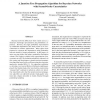ICTAI
2006
IEEE
14 years 5 months ago
2006
IEEE
The goal of spatial co-location pattern mining is to find subsets of spatial features frequently located together in spatial proximity. Example co-location patterns include servi...
ICTAI
2006
IEEE
14 years 5 months ago
2006
IEEE
We propose two Euclidean minimum spanning tree based clustering algorithms — one a k-constrained, and the other an unconstrained algorithm. Our k-constrained clustering algorith...
ICTAI
2006
IEEE
14 years 5 months ago
2006
IEEE
Traditional global search heuristics to solve constraint satisfaction problems focus on properties of an individual variable that mandate early search attention. If, however, one ...
ICTAI
2006
IEEE
14 years 5 months ago
2006
IEEE
We present MI-Winnow, a new multiple-instance learning (MIL) algorithm that provides a new technique to convert MIL data into standard supervised data. In MIL each example is a co...
ICTAI
2006
IEEE
14 years 5 months ago
2006
IEEE
Sustained emerging spatio-temporal co-occurrence patterns (SECOPs) represent subsets of object-types that are increasingly located together in space and time. Discovering SECOPs i...
ICTAI
2006
IEEE
14 years 5 months ago
2006
IEEE
Bayesian networks (BNs) have been widely used as a model for knowledge representation and probabilistic inferences. However, the single probability representation of conditional d...
ICTAI
2006
IEEE
14 years 5 months ago
2006
IEEE
Precedence constraints play a crucial role in planning and scheduling problems. Many real-life problems also include dependency constraints expressing logical relations between the...
ICTAI
2006
IEEE
14 years 5 months ago
2006
IEEE
We propose a formulation of a general-sum bimatrix game as a bipartite directed graph with the objective of establishing a correspondence between the set of the relevant structure...
ICTAI
2006
IEEE
14 years 5 months ago
2006
IEEE
This paper shows a way to speed up search by using an encoding at bit level to model a particular domain. A bitboard is an unsigned integer whose bits have been given an interpret...
ICTAI
2006
IEEE
14 years 5 months ago
2006
IEEE
Computer programs that can be expressed in two or more dimensions are typically called visual programs. The underlying theories of visual programming languages involve graph gramm...




